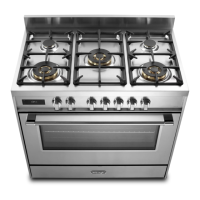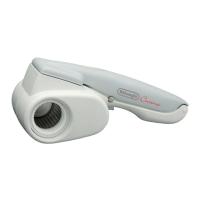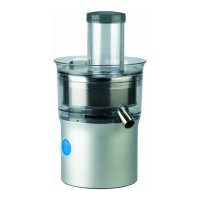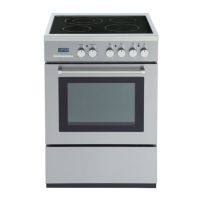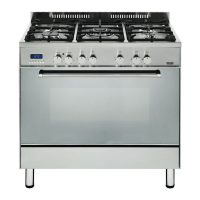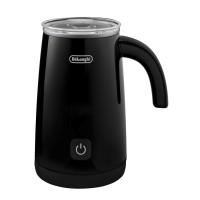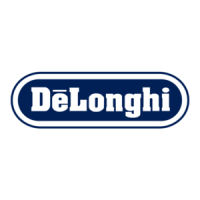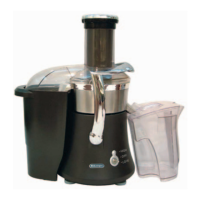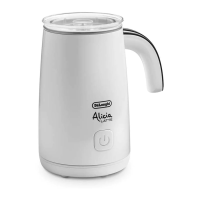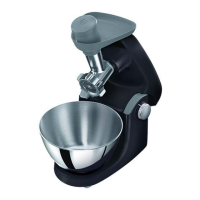Do you have a question about the DeLonghi DFS 905 and is the answer not in the manual?
States compliance with EEC directives for safety, low voltage, EMC, and general requirements.
Details the different gas burners (Auxiliary, Semi-rapid, Rapid, Triple-ring) and their power output.
Identifies and describes the numbered controls on the appliance's control panel.
Explains how to set and use the 24-hour electronic clock and its functions.
Details how to program the oven for automatic shut-off after a set cooking time.
Describes how to adjust the sound volume for alarms and timers.
Explains how to use the programmer as a standalone alarm function.
Explains the operation of each hob burner using control knobs and their positions.
Describes the ignition system for the hob burners and how it works.
Provides step-by-step instructions for igniting the hob burners.
Lists hob burners and their recommended pan diameters for optimal use.
Offers crucial safety advice for deep fat frying, including oil levels and fire response.
Instructs on the correct placement of pans and stands for the triple-ring burner, especially for wok use.
Highlights key features of the multifunction oven, including its heating elements and wattage.
Explains the different heating and cooking methods employed by the multifunction oven.
Describes how to use the function selector knob to choose oven modes.
Explains how to set the cooking temperature using the thermostat knob.
Details the operation of the oven light and its availability during cooking modes.
Explains traditional convection cooking, including temperature settings and recommended uses.
Details the grilling function, temperature settings, and safety precautions.
Explains how to use the oven's fan for defrosting food, including recommended times.
Describes hot air cooking, temperature settings, and suitable dishes.
Explains ventilated grilling, temperature, and preheating requirements.
Details how to keep food warm or slowly heat cooked food using specific oven functions.
Describes convection cooking with fan assistance, temperature settings, and recommended dishes.
Provides instructions for sterilizing food in jars using the oven.
Explains how to regenerate bread or other foods using the oven.
Details how to cook different types of food simultaneously in the oven without odor mixing.
Explains grilling and achieving an "au gratin" effect, including temperature and door closure.
Offers advice on achieving classical roasting, including temperature and cooking time considerations.
Provides instructions for using the grill, including preheating and positioning food.
A table listing recommended oven temperatures and corresponding food types for various cooking tasks.
Stresses the need for qualified installation and highlights safety aspects regarding children.
Provides contact information for booking service calls and obtaining product information.
Lists essential guidelines for safe operation, cleaning, and prohibited actions.
Reinforces safety by stating the product's intended use and the need for qualified personnel for maintenance.
Provides instructions on how to clean the hob surface effectively.
Advises on handling stiff gas taps and contacting service if issues arise.
Emphasizes checking the flexible gas tube for condition and arranging replacement by a qualified installer.
Details how to clean the oven interior and shelves after use.
Guides on cleaning specific surfaces, warning against abrasive materials.
Explains how to remove, wash, and dry burner components, stressing correct reassembly.
Details the importance of correct positioning of burner parts and keeping the electrode clean for sparking.
Instructs on the correct positioning of the triple ring burner and its cap/ring.
Provides steps for replacing the oven light bulb, including bulb specifications.
Explains how to remove the inner glass door panel for cleaning and reassembly.
Describes the storage compartment and reiterates the warning against storing flammable materials.
Details how to hang wire racks and insert grids/trays into the oven guides.
Explains the correct placement of the oven tray on the wire shelf and into runners.
Guides on removing and replacing the oven floor for cleaning, noting tray vs. floor.
Provides step-by-step instructions for safely removing the oven door.
Explains how to reassemble the oven door by reversing the removal procedure.
Specifies requirements for the cooker's placement relative to furniture and walls, and room type.
Instructions on how to fit the adjustable feet to the cooker base.
Safety warnings and procedures for moving the cooker, emphasizing two-person lift and avoiding dragging.
Explains how to level the cooker by adjusting the feet.
Recommends fitting a stability bracket for safety and details wall/floor fixing methods.
Outlines air supply requirements for the room based on BS.5540, including opening sizes for different room volumes.
States the appliance is for Natural Gas only and requires qualified installation per regulations.
Emphasizes that gas connection must be done by a qualified engineer following British Standards and regulations.
Details requirements for connecting to Natural Gas, including code of practice and supply pressure.
Explains requirements for LPG conversion, operating pressures, and the need for a qualified engineer.
Describes the physical gas inlet connection, pipe routing, and sealing checks.
Details how to replace gas injectors for different gas types, referencing a table.
Explains how to adjust the minimum flame length for the top burners.
Provides a table for selecting correct injectors based on gas type and burner, along with air requirements.
States that gas tap lubrication must be performed by a qualified technician.
Stresses the need for qualified installation and adherence to electrical regulations.
Highlights the critical requirement for the appliance to be earthed.
Provides detailed steps for connecting the mains electrical cable to the appliance.
States compliance with EEC directives for safety, low voltage, EMC, and general requirements.
Details the different gas burners (Auxiliary, Semi-rapid, Rapid, Triple-ring) and their power output.
Identifies and describes the numbered controls on the appliance's control panel.
Explains how to set and use the 24-hour electronic clock and its functions.
Details how to program the oven for automatic shut-off after a set cooking time.
Describes how to adjust the sound volume for alarms and timers.
Explains how to use the programmer as a standalone alarm function.
Explains the operation of each hob burner using control knobs and their positions.
Describes the ignition system for the hob burners and how it works.
Provides step-by-step instructions for igniting the hob burners.
Lists hob burners and their recommended pan diameters for optimal use.
Offers crucial safety advice for deep fat frying, including oil levels and fire response.
Instructs on the correct placement of pans and stands for the triple-ring burner, especially for wok use.
Highlights key features of the multifunction oven, including its heating elements and wattage.
Explains the different heating and cooking methods employed by the multifunction oven.
Describes how to use the function selector knob to choose oven modes.
Explains how to set the cooking temperature using the thermostat knob.
Details the operation of the oven light and its availability during cooking modes.
Explains traditional convection cooking, including temperature settings and recommended uses.
Details the grilling function, temperature settings, and safety precautions.
Explains how to use the oven's fan for defrosting food, including recommended times.
Describes hot air cooking, temperature settings, and suitable dishes.
Explains ventilated grilling, temperature, and preheating requirements.
Details how to keep food warm or slowly heat cooked food using specific oven functions.
Describes convection cooking with fan assistance, temperature settings, and recommended dishes.
Provides instructions for sterilizing food in jars using the oven.
Explains how to regenerate bread or other foods using the oven.
Details how to cook different types of food simultaneously in the oven without odor mixing.
Explains grilling and achieving an "au gratin" effect, including temperature and door closure.
Offers advice on achieving classical roasting, including temperature and cooking time considerations.
Provides instructions for using the grill, including preheating and positioning food.
A table listing recommended oven temperatures and corresponding food types for various cooking tasks.
Stresses the need for qualified installation and highlights safety aspects regarding children.
Provides contact information for booking service calls and obtaining product information.
Lists essential guidelines for safe operation, cleaning, and prohibited actions.
Reinforces safety by stating the product's intended use and the need for qualified personnel for maintenance.
Provides instructions on how to clean the hob surface effectively.
Advises on handling stiff gas taps and contacting service if issues arise.
Emphasizes checking the flexible gas tube for condition and arranging replacement by a qualified installer.
Details how to clean the oven interior and shelves after use.
Guides on cleaning specific surfaces, warning against abrasive materials.
Explains how to remove, wash, and dry burner components, stressing correct reassembly.
Details the importance of correct positioning of burner parts and keeping the electrode clean for sparking.
Instructs on the correct positioning of the triple ring burner and its cap/ring.
Provides steps for replacing the oven light bulb, including bulb specifications.
Explains how to remove the inner glass door panel for cleaning and reassembly.
Describes the storage compartment and reiterates the warning against storing flammable materials.
Details how to hang wire racks and insert grids/trays into the oven guides.
Explains the correct placement of the oven tray on the wire shelf and into runners.
Guides on removing and replacing the oven floor for cleaning, noting tray vs. floor.
Provides step-by-step instructions for safely removing the oven door.
Explains how to reassemble the oven door by reversing the removal procedure.
Specifies requirements for the cooker's placement relative to furniture and walls, and room type.
Instructions on how to fit the adjustable feet to the cooker base.
Safety warnings and procedures for moving the cooker, emphasizing two-person lift and avoiding dragging.
Explains how to level the cooker by adjusting the feet.
Recommends fitting a stability bracket for safety and details wall/floor fixing methods.
Outlines air supply requirements for the room based on BS.5540, including opening sizes for different room volumes.
States the appliance is for Natural Gas only and requires qualified installation per regulations.
Emphasizes that gas connection must be done by a qualified engineer following British Standards and regulations.
Details requirements for connecting to Natural Gas, including code of practice and supply pressure.
Explains requirements for LPG conversion, operating pressures, and the need for a qualified engineer.
Describes the physical gas inlet connection, pipe routing, and sealing checks.
Details how to replace gas injectors for different gas types, referencing a table.
Explains how to adjust the minimum flame length for the top burners.
Provides a table for selecting correct injectors based on gas type and burner, along with air requirements.
States that gas tap lubrication must be performed by a qualified technician.
Stresses the need for qualified installation and adherence to electrical regulations.
Highlights the critical requirement for the appliance to be earthed.
Provides detailed steps for connecting the mains electrical cable to the appliance.
| Brand | DeLonghi |
|---|---|
| Model | DFS 905 |
| Category | Kitchen Appliances |
| Language | English |
